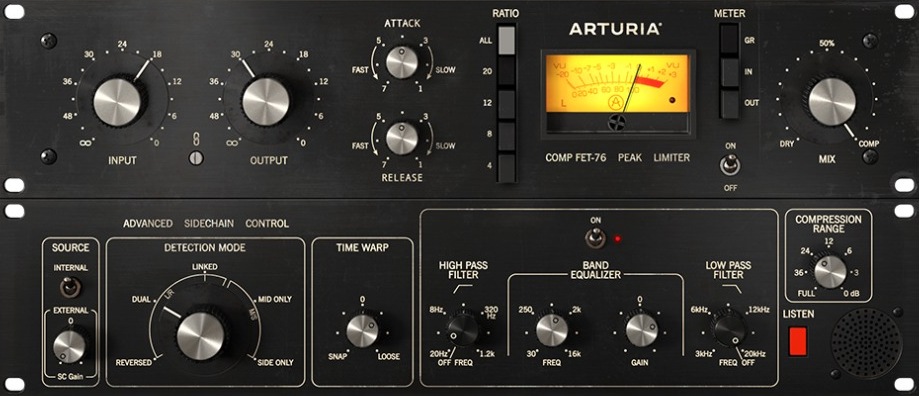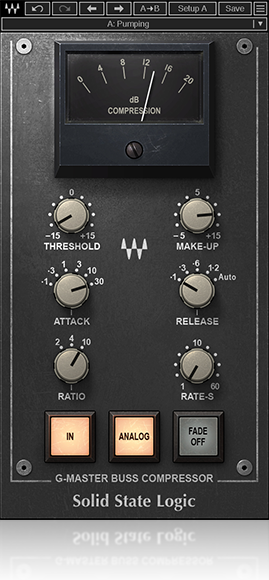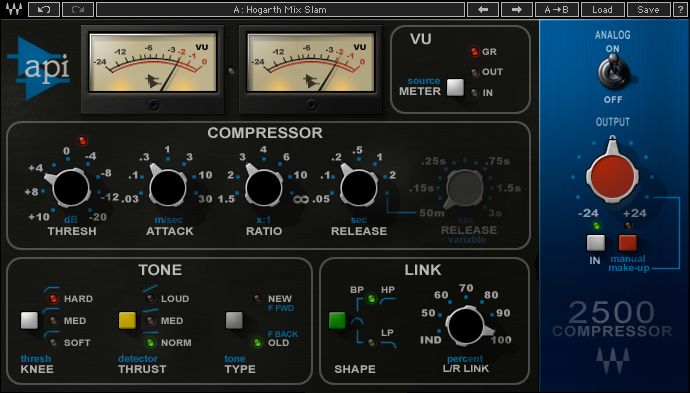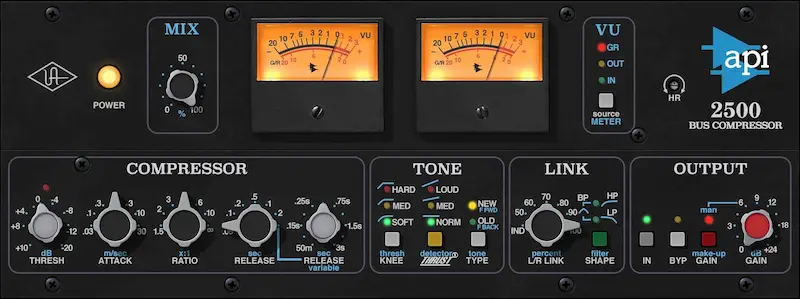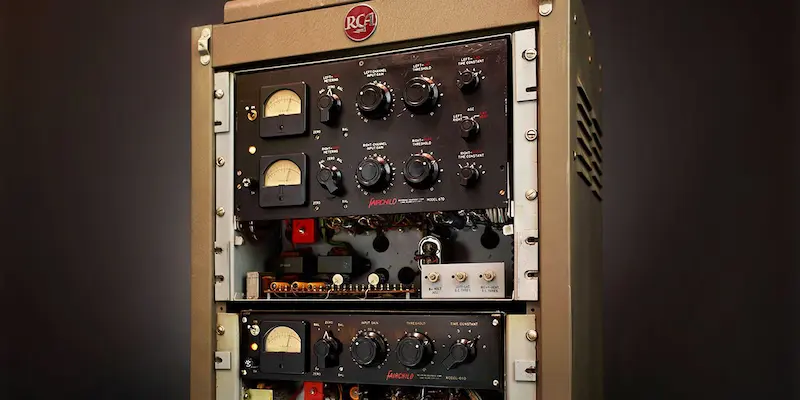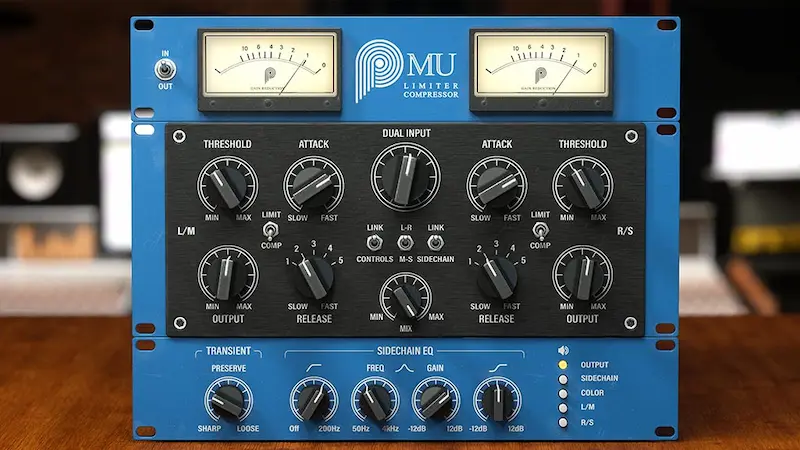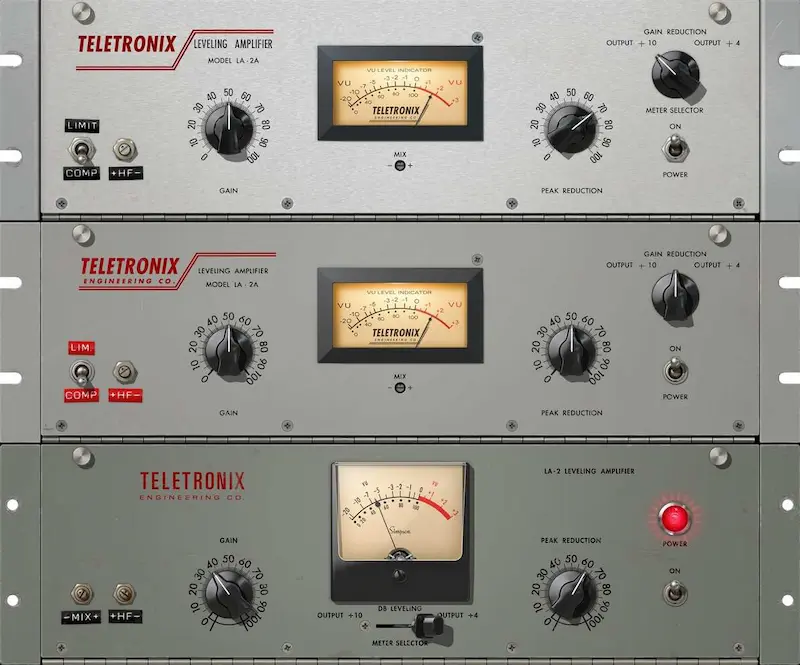The 6 Types of Compressors

Compression can be confusing. One of the best ways to learn how to use compression is by dissecting compressors down to their original hardware units, so that you can make the most out of your mixes, especially if you’ve only ever used compressors in plug-in form.
You’ve probably seen these analog compressors, whether in-person, in photos or in emulation, though you may not be sure about when to use them or what they’re best at.
Whether you’re new to mixing or you’re just getting back to basics, it’s important to understand the differences between these six analog compressors so that you can make better mix choices. Come dive in with us as we explore the six types of analog compressors and when to use each.
Note: This article may contain affiliate links, meaning I would receive a commission - at no cost to you - for any products you purchase.
Do Different Types of Audio Compressors Really Sound Different?
Yes. Each type of compressor has unique characteristics thanks to the way that their gain reduction circuits function. Passing a signal through one compressor vs. another, even if you’re applying the same amount of gain reduction, can give you a completely different sound.
The beauty of analog compressors compared to digital compressors is that they apply a bit of color to your sound, imparting slight analog saturation. In the same way that different guitar amps have different tone qualities, even when played clean, different types of compressors will sound different.
More importantly, different compressors will also react differently to the signal they are receiving, providing faster or slower compression, more glue and more. Some compressors are great on individual instruments. Here is our review of the best compressor VSTs available if you want to get into more detail about the differences.
At the same time, other compressors are better at being applied to multiple-instruments simultaneously, and are referred to as bus compressors. Here are the best bus compressor plugins.
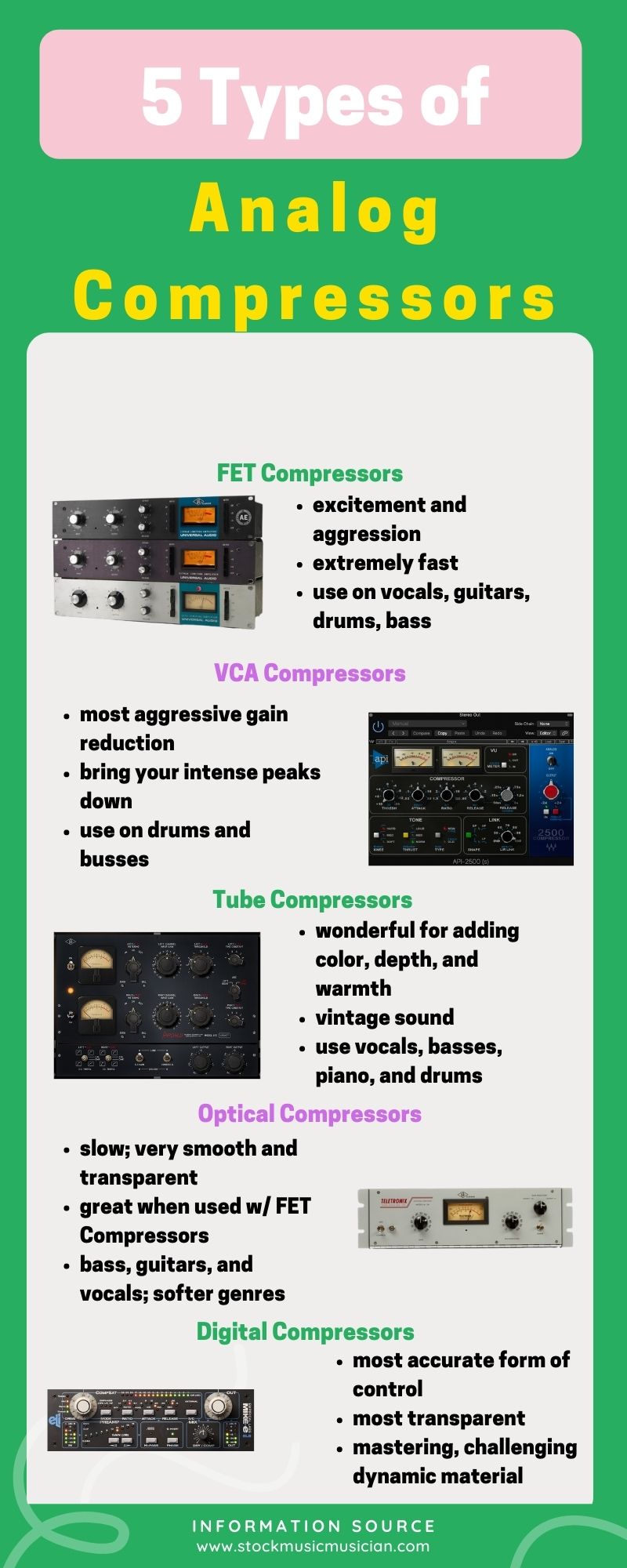
Overview FET Compressors
FET compressors make use of transistors in order to emulate tube-style compression. The beauty of FET compressors is that they color the raw signal very similar to the way tubes do. If you’re looking for transparency, look elsewhere. However, if excitement and aggression are what you’re going for, then a FET compressor is the best choice.
FET stands for “Field Effect Transistor” compression, working with the electrical field as a whole.
FET compressors are extremely fast, clamping down hard on fast transients. They’re wonderful for a wide variety of instruments, including vocals, guitars, drums, bass, or any other instrument that needs a little bit oomph. Even the slowest attack times on FET compressors are faster than other compressors, such as Variable-Mu compressors.
FET compressors are also wonderful for parallel compression, whenever you want to mix in a heavily compressed signal with a dry, non-compressed signal, giving you the best of both worlds. When driven really heavily, they give you a lush, rich distortion, especially when you use the famous All Buttons In setting.
One thing to note about FET compressors is that they operate within the constant-current portion of their output characteristic.
Best Uses of FET Compressor
FET compressors are great on all kinds of instruments, though they truly excel on vocals. When it comes to rock vocals, the 1176 is pretty much the go-to compressor. It’s often best to start with a medium attack and a fast release so you can allow the consonants in your vocals to come through while keeping them from sinking to the back.
We highly recommend FETs for mixing rock music, as they have a fast and bright characteristic that works with aggressive sounds. FET compressors are made to add color and punch to a sound, and are wonderful for sounds that are extremely percussive.
One of the famous FET compressors out there is arguably the Universal Audio 1176. You’ve likely heard this compressor on a million records. It’s one of those compressors that is so famous it’s almost hard to fathom.
The regular FET compressor makes use of a unique gain reduction circuit that has an ultra-fast attack time that moves from 20 µs to 800 µs.
You can set the ratio via the front panel buttons, including 4:1, 8:1, 12:1, and 20:1. You can even engage the buttons on the front to use them for extreme limiting, perfect for when you want to push a sound to its limits.
Arturia's CompFET 76 is usually the first compression plugin I reach for. It is versatile in controlling and shaping transients, while adding a delicious hint of warmth and color.
In our opinion, Arturia makes the best plugin emulation of the 1176 available because it offers so much flexibility in approaching a classic 1176 compressor. With a wet/dry knob, high and low pass filters, multiple detection modes and more, there is nothing this compressor plugin can't do!
Overview of VCA Compressors
VCA compressors are Voltage Controlled Amplifier compressors, which offer the most aggressive gain reduction around. If you’re dealing with any instruments or vocals that have high volume spikes or incredibly loud transients, then VCA compressors are the best choice.
If you have a track that has super intense peaks and you need compression with a much snappier response, then a VCA should be well-suited for your needs. With that said, if you simply want to level out a song and keep the average level as smooth as possible, it won’t be as good as an optical or Variable-Mu compressor.
The other thing that’s great about VCA compressors is they typically have plenty of controls, providing you with all of the versatility you could possibly need. From knee controls to variable release controls, you often have tons of choices when it comes to using a VCA compressor.
You must be careful when hitting them hard, however, as they have a tendency to distort when pushed really hard. Note: A VCA compressor isn’t technically an amplifier, as you feed the compressor with a specific level of volume before it uses an attenuator to reduce it.
Best Uses of VCA Compressors
VCA compressors are great if you want to bring your intense peaks down a little bit. They are extremely snappy, which is why they are often popular on drums or percussion. If your drums are lacking punch or snap, then we highly recommend going with a VCA compressor.
VCA compressors are also great if you’re dealing with drums that are a bit too snappy, as they can smooth out peaks and restrict the overall dynamic range without squeezing the life out of good transients.
We highly recommend using VCA compressors for drum bus compression or master bus compression.
Famous VCA Compressors
Some of the most famous compressors of all time are VCA compressors. I use both of these compressors on nearly every song I make, although they sound remarkably different from each other.
SSL G Bus
One of the most famous VCA compressors around is the SSL G Series. There isn’t a lot of material that the SSL G Bus doesn’t sound great with, making it a wonderful addition to just about any mix. Even running your mix through it without any gain reduction will give you a glued sound.
The SSL G-Master by Waves nails this sound, and is super easy to use. The SSL G Bus is best used on the master bus, adding a few dB of gain reduction to give you some transparent glue. It provides wondrous results, giving you tight low-end, and clarity in the mid-range, giving you glue, punch, and fullness. Waves offers a great emulation of this classic compressor at an affordable price.
API 2500
The API 2500 is by far one of the most popular VCA compressors around and is great for drums or mix busses. You’ll find plenty of controls on the API 2500, which can make it a bit overwhelming for beginners. The best place to start with the API 2500 is the knee controls, as there are only three settings to choose from. The softer the knee, the more transparent the sound. Waves makes a fantastic emulation of this classic VCA compressor.
The Waves API 2500 also comes with a unique Thrust control, which uses a high-pass filter as a detection input to avoid low frequencies from hitting the compressor harder.
The API 2500 is also great for entire mixes, especially if you use a soft knee. It is also my go to compressor when my drum bus just doesn't have enough punch. It's amazing how the kick and snare seem to leap from the speakers with even just a couple of dB of gain reduction. Because of this, the Waves API 2500 emulation seems to find its way on to all most of my hip hop and rock mixes.
If you want and even better version, you should check out Universal Audio's version of the API 2500, which is an end-to-end high quality emulation of the original. Wave's version is great, but UAD's emulation definitely sounds better in a head to head show down! And before you ask, no this UAD compressor does not require a UAD interface to run.
Overview of Tube Compressors
Tube compressors, otherwise known as Variable-Mu or Vari-Mu compressors, are the oldest types of compressors out there. These unique compressors make use of tube technology, which imparts unique, saturated sonic characteristics to any signal that you put into it.
They are called Variable-Mu compressors because the amount of compression that gets applied to the signal is completely variable, as it depends on how loud the signal is going in. Tube compressors are wonderful for adding color, depth, and warmth. They are also wonderful for using on an entire mix, as they can balance out the various pieces and glue them together. Tube compressors are incredibly popular with mastering engineers for this reason.
To control the amount of gain reduction they impart, tube compressors will re-bias the tube. For this reason, you get a unique type of harmonic distortion that goes along with the compression, giving you a bit of a noticeable tone.
The great thing about tube compressors is that you can apply a fair amount of compression before you begin to notice any unwanted artifacts accruing.
Best Use of Tube Compressors
People will often use tube compressors in order to add a bit of warmth to certain instruments, especially vocals, basses, piano and drums. Many people use glue compressors to add a slight bit of glue to the mix bus, as they tend to handle transients in a much more musical manner than other compressors.
If you’re going for a vintage sound, Variable-Mu compressors are a great choice. They were used endlessly on old Abbey Road Studios records, as well as many Motown records. Whether you are looking to open up the room sound on live drums or tighten up an entire mix while giving it a vintage touch, we can’t recommend anything better than a tube compressor
Famous Tube Compressor - Fairchild 670
One of the most famous tube compressors out there, often referred to as the “granddaddy of tube-based compressors, which came about in the early 1950s, is the Fairchild 670. The 670 was originally intended to cut stereo lacquer masters, processing two channels as a stereo pair. The limiter on the 670 is great for catching any unwanted peaks, as it is one of the fastest-reacting tube compressors out there.
One of our favorite uses for the Fairchild 670 is pianos. If you want to get that ultra-compressed, Beatles-style piano, then we highly recommend using the Fairchild 670. UAD makes the best Fairchild emulation out there, and now it's available to everyone (not just those that own a UAD audio interface).
And if you don't have the budget, Waves is here to the rescue with its own version of the Fairchild 670 - the Puigchild. Sometimes Waves plugins sound nearly as good as the UAD plugins (like with the API 2500), but in my opinion their Fairchild is lacking. I'd recommended saving up for the UAD version.
Manley Vari Mu
The Manley Variable Mu came about back in 1994 and has since become one of the most iconic transformer-driven compressors around. For mastering engineers, it is somewhat of a gold standard, adding cohesion and clarity to your stereo bus,
The Manley Vari Mu can be used in Mid/Side mode or Left/Right mode, perfect for precise control over your stereo imaging.
Of course, you can certainly use the Manley Vari-Mu on single instruments as well, such as lead vocals, or subgroups, such as drums, guitars, or percussion. The Pulsar Mu plugin offers a great replica of that classic Manley warmth.
Overview of Optical Compressors
Optical compressors, sometimes referred to as ‘opto’ compressors are made to convert audio into light, applying compression whenever it hits a resistor that is light-sensitive. The unique thing about optical compressors is that they’re very slow compared to other types of analog compression.
Optical compressors are also very smooth and transparent, which makes them great for a wide array of applications. If you’re looking to add a bit mojo or sheen to an uncompressed signal, then an optical compressor can give you all the butter and warmth that you’re looking for.
We absolutely love optical compressors on bass, guitars, and vocals.
It is important to note that the types of light sources found within optical compressors will vary, giving them different reaction times. Some of the light sources found in optical compressors include:
- Light Emitting Diode (LED): Semiconductor diodes that glow when you apply voltage.
- Electroluminescent Device: Dual conductive plates that are split with a small gap, very similar to capacitors.
- Fluorescent Bulbs: Low-pressure mercury vapor gas lamps that are non-linear when it comes to brightness and input voltage.
- Incandescent Bulbs: Lamps that emit light via filament heat.
Best Use of Optical Compressors
Optical compressors are great when you need transparency. They can be used on just about any type of instrument as well, making them surprisingly versatile. Optical compressors have very low distortion thanks to their LDR, as well as relatively slow attack and release times.
With naturally soft knees, frequency-dependent attack times, and transparent characteristics, we highly recommend them for softer genres, including folk, jazz, and acoustic music. Optical compressors are especially great in conjunction with FET compressors, as they can even out the aggression that they impart.
Famous Optical Compressor - LA2A
One of the most famous optical compressors around is the Teletronix LA-2A Level Amplifier, which pairs an amplifier with a compressor circuit. This iconic tube compressor has been around since the early 1960s and quickly reached legendary status. As of today, it has been used on countless records, and Universal Audio still produces Teletronix LA-2A units in accordance with their original specifications.
So you know if they make a plugin in version of it, it's certain to sound great. Thankfully they make 3 LA-2A plugins!!!
The neat thing about the gain reduction circuit on the LA-2A is that it provides gain reduction near-instantly with next to zero harmonic distortion increase. Again, Universal Audio (parent company of Teletronix) produces the definitive LA-2A emulation, and it's now available to all! In fact, UAD bundles three incredible, classic variations of the LA-2A into one package giving you a ton of tonal control for an incredible price.
This is a must-buy compressor bundle.
Digital Audio Compressors
While analog compression has many benefits, having the clarity and transparency of a digital compressor can be nice in many situations as well. Digital compressors are great because they offer unlimited headroom and, unlike analog compressors, don’t have a ton of noise built-in. Analog compressors have physical components in them that limit headroom and produce some quantity of noise.
Digital compressors have been around for quite some time and you most likely have a stock one built into your DAW that works like a charm.
The cool thing is, most developers have digital compressors that push the limits of what analog compressors are capable of. In a way, you can achieve parameters that were never possible in the analog world.
Most digital compressors come with all of the parameters you could possibly need to dial in specific sounds, including Threshold, Ratio, Knee, Attack Time, Release Time, and Output Gain. Many digital compressors have sidechain options too, as well as Mix knobs that allow you to dial in just the right amount of parallel compression.
Best Uses for Digital Compressors
Digital compressors are great for two reasons:
- They provide the most accurate form of control
- They are the most transparent
Mastering engineers will often use some form of digital compression for modern masters, as they allow for very small and accurate decisions. Many digital compressors are use multi-band functionality as well, allowing you to dial-in compression on specific frequency bands rather than on the entire signal.
Beyond that, digital compressors aren’t noisy like analog compressors, perfect for when you need a shiny, squeaky-clean compression tone that doesn’t alter the characteristics of your raw signals.
Distressor
Though the Distressor was born out of Dave Derr’s extreme love for analog compressors like the LA-2A and the 1176, it is a well-rounded digital compressor that has been used on some of the best-selling records of the past few generations.
The selling-point for the Distressor is its unique compression curves, which range from a warm, harmonically-subtle 1:1 to the all-infamous “Nuke” setting, which works like a brick wall, limiting sounds and stopping them in their tracks.
The Distressor also has many color modes, giving you the choice of how much harmonic distortion you want to impart on your signal. Essentially, the Distressor provides the best of both worlds in terms of digital control and analog warmth. SofTube has created the definitive version of the Distressor with its Mike-E VST.
Pro-C2
If you’re all about clean, transparent, high-fidelity compression, then the Pro-C2 from FabFilter is one of the best around. This high-end compressor is great for everything from subtle mastering to upfront pop vocals, adding glue, pump, and consistency in many fashions.
As with most FabFilter plugins, the C2 delivers an ultra-clean interface that shows you how the compression is working, and give you simple parameters that are even easy for beginners to navigate. FabFilterr is slowly becoming the gold standard for digital plugins and we can’t think of another digital compressor that lives up to this one.
Learn more about Mixing with Compression
This is only one part of mixing with compression! Luckily, I've put together a bunch more articles to help you master this crucial mixing skill!
- How to Use a Compressor: Learn to Mix with Compression Quickly!
- Sidechain Compression Explained for Beginners & Key Settings
- 3 Tips for Using a Sidechain Compressor to Add Punch & Clarity
- Multi-band Compression Tutorial for Great Vocals, Drums & More!
- How to Use Mid-Side Compression for Amazing Recordings!
- How to Use Parallel Compression for Powerfully Punchy Mixes
- Should You Compress Reverb? The Real Answer Finally Revealed.
- The 5 Types of Compressors (And Exactly When To Use Each)
- 10 Vocal Compression Mixing Tips (Including Best Settings)
- 9 Powerful Drum Compression Techniques for Punchy Pro Mixes
- Loud, Punchy Kick Drums with these Compression Settings
- How to Compress Snare - Use *These* Settings Punchy Snares
- Exactly How to Compress Bass for Tight Low End Thump!
- How Compress Acoustic Guitar Perfectly, Every time
- How to Compress Synthesizers: Best Compressor Settings for Synths
- How to Compress Organ: 4 Steps to a Great Mix!
- How to Compress Percussion: Compression Settings for Everything
- How to Compress Strings: 8 Magic Settings You Need to Know
From a Frustrated Producer in a Ragtag Bedroom Studio to Major Placements on TV Earning $1,000s!
My name is Evan, and I've been making music since around 3rd grade. I'm from San Diego, California, but I've lived in Washington, DC for the last 20 years.
While I still have a full-time day job, I have created systems that have allowed me to produce dozens of songs a year in my spare time.
My songs have been on Netflix, TV shows like the 90 Day Fiance, an award-winning indie film, and NPR’s “All Thing Considered.” They've also been streamed millions of times.
In addition to being a music producer, I am passionate about teaching people how they can make professional-sounding music and earn money licensing it, all in their spare time.
Thousands of musicians, like yourself, have trusted me to guide their musical journey. My YouTube videos have been watched nearly a million times. And my story has been in Forbes, Side Hustle Nation, and the Side Hustle School.

